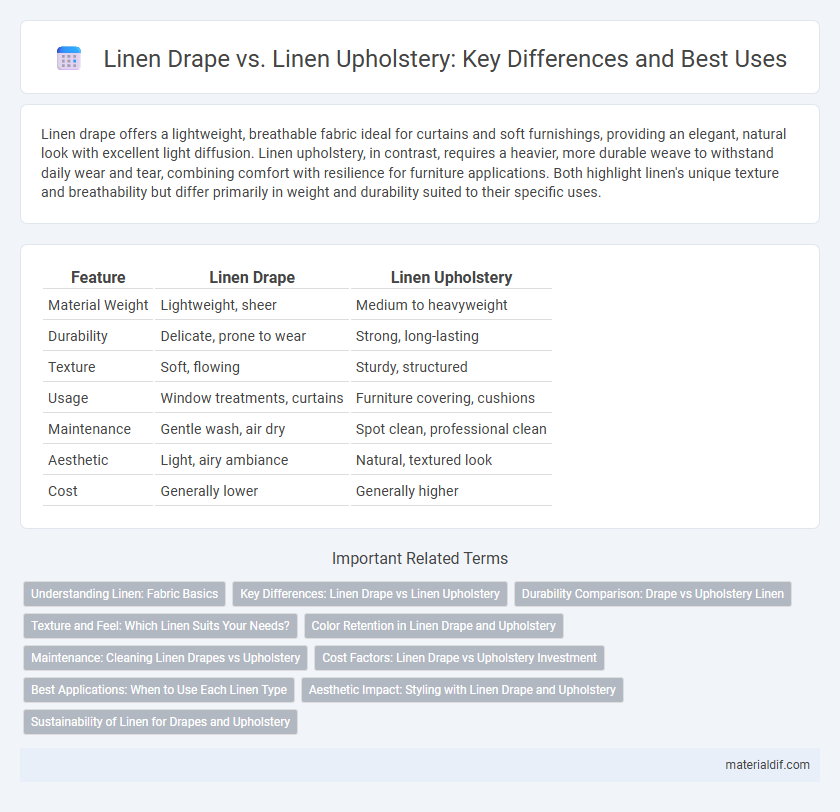Linen drape offers a lightweight, breathable fabric ideal for curtains and soft furnishings, providing an elegant, natural look with excellent light diffusion. Linen upholstery, in contrast, requires a heavier, more durable weave to withstand daily wear and tear, combining comfort with resilience for furniture applications. Both highlight linen's unique texture and breathability but differ primarily in weight and durability suited to their specific uses.
Table of Comparison
| Feature | Linen Drape | Linen Upholstery |
|---|---|---|
| Material Weight | Lightweight, sheer | Medium to heavyweight |
| Durability | Delicate, prone to wear | Strong, long-lasting |
| Texture | Soft, flowing | Sturdy, structured |
| Usage | Window treatments, curtains | Furniture covering, cushions |
| Maintenance | Gentle wash, air dry | Spot clean, professional clean |
| Aesthetic | Light, airy ambiance | Natural, textured look |
| Cost | Generally lower | Generally higher |
Understanding Linen: Fabric Basics
Linen drape features lightweight, breathable qualities with a smooth texture ideal for curtains and soft furnishings, emphasizing fluidity and natural wrinkles that enhance aesthetic appeal. Linen upholstery requires a heavier, more durable weave with stronger tensile strength, designed to withstand frequent use and resist abrasion while maintaining linen's characteristic breathability. Understanding the fabric composition, thread count, and weave density is essential to differentiate between linen used for drapes and upholstery, ensuring optimal performance and durability in each application.
Key Differences: Linen Drape vs Linen Upholstery
Linen drapes are lightweight, breathable, and designed to hang softly, allowing natural light to filter through while providing privacy. Linen upholstery is heavier and more durable, treated to withstand daily wear and stains, making it ideal for furniture surfaces. Key differences include fabric weight, durability, and functional use, with drapes enhancing ambiance and upholstery ensuring long-lasting protection.
Durability Comparison: Drape vs Upholstery Linen
Linen upholstery is specifically treated and woven to enhance strength and abrasion resistance, making it significantly more durable than linen drape, which is lightweight and designed for softness and fluidity. Upholstery linen withstands daily wear, tear, and heavy use in furniture applications, while drape linen prioritizes aesthetic appeal and breathability over durability. This fundamental difference in weave density and finishing processes results in upholstery linen having superior longevity compared to drape linen in high-traffic environments.
Texture and Feel: Which Linen Suits Your Needs?
Linen drape fabric features a lightweight, airy texture that flows effortlessly, making it ideal for curtains and soft furnishings requiring gentle movement. Linen upholstery fabric is denser and more durable, designed to withstand wear and provide a firm, structured feel on furniture surfaces. Choosing the right linen depends on whether you prioritize the soft, breathable quality of drapes or the robust, textured finish needed for upholstery durability.
Color Retention in Linen Drape and Upholstery
Linen drapes typically exhibit superior color retention due to their lighter exposure to wear and sunlight compared to upholstery, which endures more frequent friction and direct contact. The natural fibers in linen resist fading, but upholstery often requires specialized dye treatments or protective coatings to maintain vibrant color over time. UV-resistant finishes on linen drapes enhance color preservation, making them more durable in bright room settings than standard linen upholstery.
Maintenance: Cleaning Linen Drapes vs Upholstery
Linen drapes require gentle cleaning methods, such as dry cleaning or light hand washing, to preserve fabric integrity and prevent shrinkage. Linen upholstery demands more frequent spot cleaning and professional deep cleaning due to exposure to daily wear, dirt, and stains. Regular vacuuming and prompt stain treatment are essential for maintaining the appearance and longevity of linen upholstery compared to the relatively lower maintenance needs of linen drapes.
Cost Factors: Linen Drape vs Upholstery Investment
Linen drapes typically cost less due to lighter fabric requirements and simpler construction, while linen upholstery demands thicker, more durable fabric and additional padding, driving up expenses. Upholstery also involves skilled labor for sewing and fitting, increasing overall investment compared to drapery. The long-term durability and wear resistance of linen upholstery justify its higher initial cost when compared to linen drapes.
Best Applications: When to Use Each Linen Type
Linen drape excels in lightweight, breathable applications such as curtains, window treatments, and decorative accents where natural texture and softness enhance interior aesthetics. Linen upholstery suits high-traffic furniture requiring durability and resistance to wear, offering a sturdy, natural fabric that ages well over time. Use linen drape for diffusing light and creating a relaxed ambiance, while linen upholstery is ideal for sofas, chairs, and benches needing both comfort and longevity.
Aesthetic Impact: Styling with Linen Drape and Upholstery
Linen drape offers a light, airy aesthetic that enhances natural light and creates a relaxed, elegant ambiance with its soft, flowing texture. Linen upholstery provides a tactile, structured appeal, adding warmth and durability to furniture while maintaining a sophisticated, organic look. Combining linen drapes with upholstery balances softness and robustness, resulting in a cohesive, stylish interior design that emphasizes natural fibers and timeless charm.
Sustainability of Linen for Drapes and Upholstery
Linen drapes and upholstery both offer exceptional sustainability due to linen's natural fiber composition and biodegradability, reducing environmental impact throughout its lifecycle. Linen's cultivation requires significantly less water and pesticides than cotton, making it an eco-friendly choice for both window treatments and furniture coverings. Its durability ensures longer-lasting products, minimizing waste and promoting sustainable living environments.
Linen Drape vs Linen Upholstery Infographic

 materialdif.com
materialdif.com